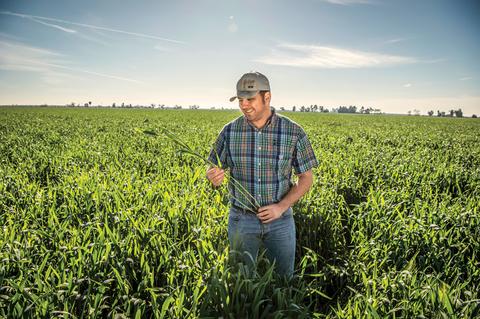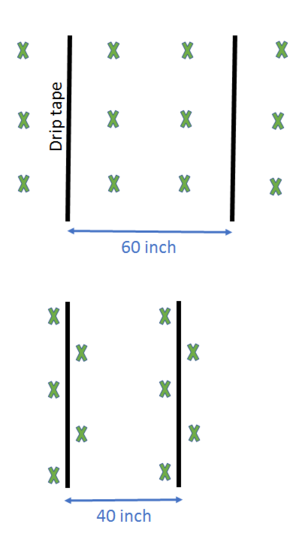Nate Ray - De Jager Farms
Nate Ray: Minimum Tillage and Subsurface Drip Irrigation in Dairy Forage Production
Nate Ray is the general manager of DeJager Farms Inc., responsible for producing forage feed for 8 different diaries with a total of 25,000 cows on 17,000 acres of land near Chowchilla. About 8000 acres are in alfalfa, another 8000 in a corn-wheat rotation, and “since enough forage is produced for the dairies,” 1000 acres are in almonds and tomato. He has focused on improving tillage, irrigation, and nutrient management practices at the farm.

Minimum Tillage
Nate’s interest in minimum tillage has its origin in the friendship with a neighbor who went to school in the Midwest where he was exposed to conservation tillage practices, implemented there primarily to control erosion. The two kept talking, tinkering with equipment and trying out new things. Nate went to Arkansas and Iowa to look at minimum tillage equipment and study those systems.
About seven years ago, soon after joining DeJager Farms, Nate started with minimum tillage on 400-500 acres, then increased the trial to 1600 acres. After four years in minimum tillage, these plots outperformed the other plots by an average of 3 tons per acre. Since 2015, all 8000 acres of the wheat-corn rotation are under minimum tillage.
Nate uses only strip tillage before planting corn. Before wheat, two pieces of equipment, a subsoiler and an ‘excelerator’ are used. The subsoiler, which breaks up compaction to a depth of 20 inches, is designed to cause minimum disturbance at the soil surface. They tried to farm without subsoiling, but the wheat yields following corn without subsoiler use were always lower. The excelerator is a vertical tillage tool that cuts residue, mixes soil and solid manures, such as ‘separator’ (i.e. mechanical screen solids), and does not break up aggregates in the top 3 inches as much as traditional disking does. The whole farm can be maintained with three pieces of equipment: Subsoiler, excelerator, and planter.
Initially, the motivation for minimum tillage was to cut costs for labor and fuel and to reduce the time spent preparing fields, but they also recognized other benefits, such as less dust, water savings and greater soil moisture retention. Building organic matter is a declared goal because of the many perceived benefits. Less soil disturbance and year-round growing of crops are the means of achieving higher soil organic matter. “We always have something growing, if not forages, then cover crops,” Nate says. This year two fields are planted to legume/cereal cover crop mixtures. The reduced tillage and farming to build organic matter is also affecting soil biology. Nate finds earthworms in all fields.
Reduced moisture losses due to the lower tillage intensity gives Nate and his team more flexibility with planting dates. With the right amount of moisture in the ground, they have at times planted hundreds of acres of corn without irrigation needed to germinate the seeds although 80-90% of the time, they have to sprinkler-irrigate to get the corn crop started.
Nate thinks compaction is the greatest enemy of minimum tillage systems. “Heavy equipment should not be on wet ground,” he says. “The challenge of being successful with minimum tillage is timing and planning of field preparation.” Wet springs can be a problem. Nevertheless, a minimum tillage regime is advantageous because one can get into a field sooner under minimum than conventional tillage. For example, with conventional disking to break up stubbles etc., it used to take 27-28 days between harvesting wheat and planting corn. With strip tillage, they can plant within 16 days. Using lighter tillage tools is another strategy to counteract compaction. Nate is working on lightening up the equipment they are now using.
Another critical operation that potentially causes compaction is harvesting. Avoiding compaction by harvesting equipment is a much greater challenge with silage corn than grain since the ground is usually dry when the latter is harvested. At DeJager they wait up to 20 days with harvesting corn after the last irrigation to lessen the impact of harvesting equipment. They can do so even though much of the farm has sandy soils. Nate attributes the soil’s ability to retain moisture for so long to soil organic matter they build with minimum tillage, intensive cropping, and manure inputs.
Subsurface Drip Irrigated Alfalfa
Nate started subsurface drip irrigation in alfalfa eight years ago. It took about four years “to figure things out because every field behaves differently,” Nate recounts. “It takes that long for each and every field.” The effort was well worth it: Yields on average increased by 25-30% with subsurface drip irrigation, and water use could be reduced to about 42 inches vs. previously 50-60 inches per year.
They found that 40-inch spacing between drip lines works better than 60-inch spacing. In general, they use relatively short, but frequent irrigation sets of 3 – 6 hours, depending on crop stage. The trickiest period to figure out was the time after harvest. Irrigating with a small irrigation right after harvest was good to get re-growth started, but too vigorous re-growth when hay was still drying in the field was undesirable. Applying the right amount of water after harvest is a challenge in spring and fall when it takes longer to dry the hay than in summer.
SDI in Corn
“So far,” Nate says, “we have seen that yield increases with SDI are possible in corn as well, and there is potential for water savings.” In the corn-wheat rotation, synthetic N was applied as fertigation during the first two years of the trials, followed by two years of liquid manure/freshwater mixes applied through the drip system, a technique developed in collaboration with Sustainable Conservation and Netafim. Nate thinks that the lateral spacing of drip lines (60 inches) is the reason why the system has not performed satisfactorily and wants to go to 40 inch spacing of drip lines and twin rows of corn (see Figure). With this layout, all corn plants will be closer to the drip lines. He hopes this planting configuration will accommodate 45,000 rather than 40,000 plants per acre. With the 60-inch spacing they tried before, the plants are too close if more than 40,000 plants per acre are planted.
Nutrient Management
In the alfalfa fields that are still flood-irrigated, lagoon water is applied one to three times per year to provide P and micronutrients. In the SDI alfalfa fields, synthetic P, micronutrients and a small amount of N are applied through the drip lines.
Corn and wheat are mostly fertilized with lagoon water. If N levels are low at planting, as determined by soil sampling, starter fertilizer will be added. At DeJager, soil inorganic N to a depth of one foot is sampled pre-plant in every field, every year. One of the challenges of using SDI with corn was to deliver enough N to the crop. Supplying enough N to wheat is also problematic with this system. Nate thinks they need to monitor the supply and uptake of nutrients by the crops more closely and add fertilizer if necessary.
One area where more knowledge is needed is plant N availability from soil resources. For example, as soil organic matter increases in these systems, a significant amount of N may be tied up and it is not known at what rates this N becomes available to plants.
Be it tillage, irrigation or nutrient management, Nate is always tinkering and trying out new approaches, but he is also patient and acknowledges that solutions to management in individual fields are often found only after several years of trials.

